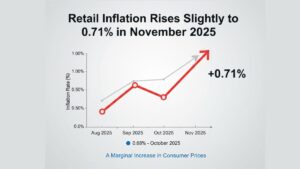India is on track to become a high-income nation by 2047, with its GDP projected to reach between $23 trillion and $35 trillion, according to a recent report by Bain & Company in collaboration with Nasscom. The services sector is expected to be the biggest contributor, making up 60% of GDP, while manufacturing will account for 32%. The report highlights that technology, workforce expansion, and strategic investments in key sectors will play a crucial role in India’s economic transformation.
How Will India’s Workforce Shape Its Economic Growth?
With nearly 200 million people set to join the workforce in the next two decades, India has a unique opportunity to accelerate job creation and economic expansion. However, the report warns of a potential workforce shortfall of around 50 million by 2030 if skill development and STEM (Science, Technology, Engineering, and Mathematics) education are not prioritized. To bridge this gap, the government and private sector must focus on enhancing vocational training, digital literacy, and industry-specific skills to ensure India remains competitive in the global job market.
What Role Will Technology and Manufacturing Play?
Technology-driven advancements are key to India’s future growth. The report emphasizes the role of AI, touchless manufacturing, and chip design in increasing efficiency and innovation. The manufacturing sector’s export share is expected to rise from 24% today to between 45% and 50% by 2047, while its contribution to GDP could grow from 3% to 8%-10%. Renewable energy will also play a significant role, with its share in total energy production projected to jump from 24% in 2023 to 70% by 2047.
Which Sectors Will Drive India’s High-Income Status?
The report identifies five key industries—electronics, energy, chemicals, automotive, and services—as strategic growth drivers. For example, the auto-component export sector is expected to reach $200-250 billion by 2047, fueled by a shift towards electric vehicles (EVs). Additionally, the services sector will remain a major contributor to GDP, with IT, finance, and healthcare leading the way. To maximize this potential, India needs stronger public-private partnerships, sector-specific investment roadmaps, and reduced dependency on global supply chains.
Challenges and the Road Ahead
Despite strong growth projections, challenges remain. Infrastructure development, skill gaps, and innovation gaps must be addressed for sustained economic success. Investing in transport, digital infrastructure, and R&D will be crucial to strengthening India’s position as a global economic powerhouse. As the country moves towards its 2047 goal, a balanced strategy that integrates workforce development, technology, and industrial growth will be essential.
India’s High-Income Status by 2047: Key Highlights
| Key Aspect | Details |
|---|---|
| Why in News? | India is projected to become a high-income country by 2047, driven by the services sector. |
| GDP Projection | Estimated to reach $23 trillion – $35 trillion by 2047. |
| Major Growth Driver | Services sector to contribute 60% of GDP, manufacturing to reach 32%. |
| Workforce Growth | 200 million people to enter the workforce; possible 50 million shortfall by 2030. |
| Technology Impact | AI, chip design, touchless manufacturing, and renewable energy to drive efficiency. |
| Manufacturing Exports | Expected to rise from 24% to 45%-50% by 2047. |
| Renewable Energy Growth | Share in total energy production to increase from 24% (2023) to 70% (2047). |
| Key Sectors for Growth | Electronics, energy, chemicals, automotive, and services. |
| Challenges | Infrastructure gaps, skill shortages, and innovation needs must be addressed. |
| Path Forward | Investment in digital infrastructure, R&D, and workforce development is essential. |



 India’s Forex Reserves Rise by $1.68 Bil...
India’s Forex Reserves Rise by $1.68 Bil...
 India’s Net Direct Tax Collections Rise ...
India’s Net Direct Tax Collections Rise ...
 Retail Inflation Rises Slightly to 0.71%...
Retail Inflation Rises Slightly to 0.71%...







